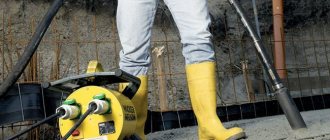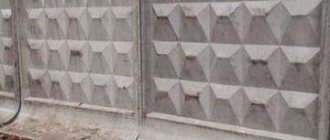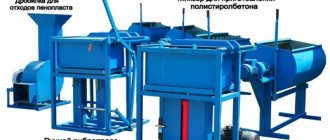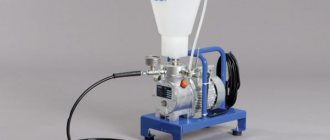The development of the construction sector in the country requires an increasing amount of high-quality building materials. Equipment for the production of concrete helps solve the problem of producing mortar for further sale or own consumption. Structures made from this material and the mixture itself have been used in the construction of objects for many decades.
Equipment classification
The prepared concrete mixture or solution is transported by various vehicles.
From the plant mixers (mixing shop of the concrete concrete plant), the finished mixture is transported to the consumer by concrete trucks, dump trucks, concrete mixer trucks, belt conveyors, using concrete mortar pumps and special equipment. Equipment for transporting concrete and mortar mixtures is classified:
a) by the nature of the work - cyclical or continuous action;
b) for its intended purpose - for transporting concrete, mortars; c) according to the method of relocation - stationary, portable, mobile, collapsible.
Continuous equipment includes belt and other conveyors, pumping and pipeline machines, and pneumatic conveying units. This equipment is used for large volumes of concrete work and on special structures. Transportation, delivery and laying of concrete and mortar mixtures in the manufacture of reinforced concrete products is carried out mainly by concrete pavers and concrete distributors. Dump trucks, as a rule, are used in the landfill method of producing reinforced concrete products.
Why is it needed: main purpose
Concrete mortar is often used for the construction and repair of various structures. Preparation of the material is very labor-intensive; even in artisanal conditions, it will be difficult to manually prepare a small amount of the mixture for pouring. Machines for preparing small volumes of mortar, called concrete mixers, are simple and inexpensive. Industrial production of concrete is carried out at special enterprises using specific devices. It is physically impossible to provide a large construction site with mortar prepared using a simple concrete mixer. Therefore, special equipment is purchased and installed by organizations that prepare this popular and still indispensable product.
The current level of retail sales of small batches of concrete mortar produced by small businesses contributes to the rapid return on costs for the purchase of equipment for the production of building mixtures.
Concrete pavers and concrete distributors
They are used for the manufacture of reinforced concrete products as part of technological equipment complexes.
Equipment is classified according to the following criteria:
- purpose: concrete pavers, concrete distributors, texture distributors;
- method of relocation: stationary, mobile, suspended, ground;
- designs: single-, multi-hopper, with a fixed and movable hopper, with attachments (in the form of attachments), portal, semi-portal;
- control: with local, with remote. Concrete distributors are designed for transporting and dispensing concrete (mortar) mixture into a mold without leveling it.
Concrete pavers, in addition to bunkers for concrete or mortar, have additional devices for distributing and (or) compacting the mixture, as well as for finishing the surface of the molded product.
Concrete pavers and concrete distributors are equipped with gates, feeding and distribution devices, the main ones of which are shown in Fig. 1.
Rice. 1. Designs of gates, feeders and distribution devices of concrete pavers : a - bunker with a sector gate; b - belt feeder; c - the same, with a funnel; g - the same, with a vibrating attachment; d - screw (screw) feeder; e - vibrating tray feeder; g - screw distribution device; h — smoothing (distributing) roll; and - spoon feeder
In Fig. 1, and a hopper with a sector gate is presented, which can be installed on concrete pavers and concrete distributors. When the shutter opens, the mixture begins to flow into the mold. To improve the flow of the mixture, vibrators are installed on the walls of the bunker. The hopper can be installed stationary on the stacker portal or on a self-propelled cart. The shutter drive can be manual, electromechanical, hydraulic or pneumatic.
In Fig. 1, b shows a concrete paver with a belt feeder, the most common. A belt feeder is located under the hopper installed on the portal. The hopper has a storage tank with a damper to regulate the thickness of the mixture layer on the belt. The belt feeder is installed horizontally or with an inclination of 5...8° to ensure the flow of cement milk in the direction of dispensing the concrete mixture. Feeder belt width 200…2000 mm, moving speed 0.08…0.25 m/s.
In Fig. 1, c shows a concrete paver with a belt feeder and a rotary funnel. Uniform filling of the mold compartments is carried out due to the reciprocating movement of the stacker on rails along the molding line and periodic turns of the discharge hopper.
A concrete paver with a belt feeder and a vibration attachment, which is suspended from the frame and equipped with a mechanism for moving in a vertical plane and a vibration exciter, is shown in Fig. 1, g. This design is used for the manufacture of reinforced concrete slabs with a height of up to 200 mm.
A concrete paver with a screw (screw) feeder (Fig. 1, d) is used for forming certain types of reinforced concrete products and pipes. The feeder drive is adjustable. Some designs do not have a movement mechanism. The screw rotation speed is 0.08...0.42 s–1, its diameter is up to 150...400 mm.
A concrete paver with a vibrating tray feeder (Fig. 1, e) consists of a hopper, a vibrating tray suspended from the hopper on vibration-isolating elements, equipped with an electromagnetic vibration exciter. The nozzle through which the mixture is fed into the mold is carried out by a lifting-lowering mechanism.
A screw distribution device (Fig. 1, g) is installed on concrete pavers to uniformly distribute the concrete mixture after it is laid across the entire width of the form, which can be up to 3000 mm or more.
The smoothing roller (Fig. 1, h) is used in the construction of concrete pavers to uniformly distribute the mixture across the width of the form, as well as to compact and finish the surface of the molded reinforced concrete product.
A spoon feeder (Fig. 1, i) is used for the manufacture of reinforced concrete pipes.
Some paver designs are equipped with smoothing devices in the form of bars, slats and disks.
Accessories
Bucket for concrete.
Such devices include tools that are necessary for transporting mortar within construction sites using a crane or other lifting device. For example, this:
- buckets for concrete;
- other containers for concrete mortar.
Of course, assistive devices don't stop there. There are devices used to pump the mixture to the required places:
- mortar pump;
- concrete pump;
- pneumatic blowers.
There is also highly specialized specialized equipment:
- shotcrete installations;
- plastering systems;
- trowelling machine.
Return to contents
Container equipment
These devices are necessary to facilitate the transportation of the solution to inaccessible areas through the use of cranes or other similar mechanisms. They also store the mixture that is used at that moment. For example, a boat is necessary for transporting the solution around the site, but also for short-term storage. A bucket of concrete can be of two types:
- shoe. The solution is placed in it only in a horizontal state, but during transportation or unloading it takes on a vertical state;
- cone. This container must always be kept upright. To make it more stable, special metal rings are mounted on the lower part.
Any type of tub is made of special steel, the width of which is about 3 millimeters. Additionally, special loops are made on the tub. They are necessary so that the crane can pick up the tank during transportation. However, this is not the only type of existing packaging. There are also smaller options - boxes. They are made of steel sheet, with additional 4 loops for slings. Boxes can vary in shape:
- made in the shape of trapezoids;
- boxes with a semicircular bottom;
- made in the shape of a parallelepiped, but one of its sides is beveled.
The production of different types of containers also involves insulated options. Their use is advisable in the cold season.
Return to contents
Specialized equipment
In production, narrowly targeted devices are sometimes used.
Return to contents
Mortar pumps
Screw (gerotor) mortar pump is professional equipment for pumping viscous and abrasive solutions.
Necessary for moving concrete mortar to the required place of application. The difference between a concrete pump and a mortar pump is that they can pump solutions of different fractions. There may also be differences between pumps in:
- productivity;
- operating time;
- drive type;
- number of installed cylinders;
- way of functioning.
It is advisable to install the pump so that it is as convenient and mobile as possible. Pumps are not the only type of equipment that is used for pumping concrete solutions. A pneumatic supercharger is used for the same purposes. Its advantage is the ability not only to pump the mixture horizontally, but also vertically, as well as to a height. They work in this way:
- The concrete solution is prepared in the container, then the container is tightly sealed with a lid;
- After closing the tank, the solution moves under the influence of compressed air to the required point.
Return to contents
Torect installations
Necessary for preparing a coating from a mixture using the spray method. The dry components of the solution are placed into the receiving container of the equipment, after which the drum moves the solution in doses through a special pipe to the nozzle. In the nozzle, under the influence of compressed air, the constituent elements mix even more thoroughly with each other and with water. Thanks to the very fast flow rate of the solution through the nozzle, it adheres best to the required surface. Naturally, to increase the adhesion rate, it is advisable to prepare the surface to be treated in advance - remove foreign elements, dirt, etc. Since the equipment is small in size, it is quite easy, simple and convenient to work with.
Return to contents
Plaster systems
According to their operating principle, these devices are similar to Torect installations. In addition, they are even visually similar. The main difference between them is that in this equipment the mixture is prepared in the tank immediately with the addition of water.
Return to contents
Grouting units
Gasoline trowel for concrete.
Necessary for leveling the finished concrete surface, because it is known that a fresh coating has a large number of irregularities. And since finishing products do not have good adhesion to such a surface, it means that it must be rubbed down. Grouting units cope with just such tasks. There are two types of such installations:
- gasoline. Operated only in open space with constant access to fresh air;
- electric. This type can be used in any conditions, it is universal.
The installation contains the main working mechanisms, these are metal disks and screws. These discs are made of special steel, which is used for roughing operations. If a cleaner design is required, then use screws that are made of higher grade steel. In certain types of trowels, it is possible to adjust the angle of the screws. The degree of influence of the installation on the concrete surface depends on this indicator.
The productivity of this type of device is also largely dependent on the number of rotation speed modes, the size of the metal disks and the diameter of the screws, the productivity and intensity of the equipment. The visual appearance of the device also depends on productivity and volume - there are manual models and models controlled by the operator.
Return to contents
Vibrating plates and vibrators
Necessary to ensure that there are no voids in the finished product. There are several types:
- manual;
- self-propelled;
- hanging.
Which type of device to use depends on the components of the mortar, reinforcement, and the intricacies of the building system. Their operating principle is as follows: through vibration, friction between the components in concrete is reduced, the solution becomes denser and preparation occurs faster.
Return to contents
Concrete cutters
Their main purpose is to cut special seams over large areas. If this is not done, then there is a high possibility that a large concrete mass will simply burst due to temperature differences.
Structures of concrete pavers and concrete distributors
The concrete paver SMZh-162 (Fig. 2) is designed for laying concrete mixture into a mold for the production of reinforced concrete slabs up to 3600 mm wide. The concrete paver consists of a portal-type frame, a large self-propelled hopper with a belt feeder, two small self-propelled hoppers with belt feeders, vibrating nozzles with a lifting-lowering drive, a smoothing device, drives for moving the concrete paver, a trolley and belt feeders, and electrical equipment. The vibrating nozzle is suspended under the hoppers on a hinge-lever device so that a mixture from all three hoppers is supplied to its storage tank. The vibrating attachment is equipped with a smoothing device - a beam that performs reciprocating movements from a special drive in the direction perpendicular to the movement of the concrete paver.
The drive of the concrete paver includes a four-speed electric motor. Single-speed electric motors are used to drive belt feeders. The water sprayer is designed to irrigate the surface of the pallet before placing the concrete mixture into the form. Water is supplied to the water sprayer from the workshop system. The concrete paver is controlled from the operator's platform located on one of the sidewalls of the portal.
The kinematic diagram of the concrete paver movement drive is shown in Fig. 3.
The kinematic diagram of the concrete paver belt feeder drive is shown in Fig. 4.
When producing pipes using the centrifugation method, spoon and belt feeders are used to place the concrete mixture into a mold.
Rice. 2. Concrete paver SMZh-162 : 1 - frame; 2 — vibration attachments; 3 — operator’s platform with control panel; 4 - large hopper with feeder; 5 - small hopper with feeder; 6 — right drive of movement; 7 — drive for raising and lowering vibration attachments; 8 — stand for cable suspension; 9 - left travel drive
Rice. 3. Kinematic diagram of the concrete paver movement drive : 1 - electric motor; 2 - gearbox; 3 - chain drive; 4 - connecting shaft; 5, 6 - bevel and cylindrical gears; 7, 8 - drive and non-drive wheels
Rice. 4. Kinematic diagram of the belt feeder drive : 1 - shaft; 2 — gear transmission; 3 - gearbox; 4 - electric motor; 5 - coupling; 6 — chain drive; 7 - drum; 8 — feeder belt; 9 — tension device
The spoon feeder shown in Fig. 5, consists of a trolley 1 and a long hopper (spoon) 2. The trolley is a mobile platform on four single-flange wheels, two of which are driven. A pedestal 3 is mounted on the trolley, inside of which there are drives for moving the trolley, a vibrator-driver 4, a vibrator-distributor 5 and a hydraulic drive. The spoon has replaceable nozzles, the capacity of which is set depending on the size of the molded pipes. Concrete mixture from a self-propelled bunker fills a spoon. Then the cart with the spoon moves to the right (according to the drawing) and is inserted into the mold mounted on the centrifuge. The end of the spoon is placed on the rack 6. Then the hydraulic cylinder 7 opens the gate 8, at the same time the vibrators 4, 5 are turned on. After unloading the concrete mixture from the spoon, the gate 8 is closed and the vibrators are turned off. The vibrator distributor is moved away from the laid concrete mixture by hydraulic cylinder 9. Then the trolley moves to the left (according to the drawing), and the pipe is formed. Then the work cycle is repeated.
Rice. 5. Spoon feeder : 1 - trolley; 2 - bunker; 3 - cabinet; 4 — vibrator-stimulant; 5 — vibrator-distributor; 6 - stand; 7, 9 — hydraulic cylinder; 8 - shutter
The considered feeder is used in the production of pipes with a diameter of 0.4÷0.9 m. When forming pipes with a diameter of up to 1.5 m, feeders are used in which the concrete mixture is unloaded from a spoon by turning the latter.
The design of a belt feeder for the production of reinforced concrete non-pressure pipes is shown in Fig. 6.
Rice. 6. Belt feeder SMZh-425 for the production of non-pressure reinforced concrete pipes using the centrifugation method : 1 - belt conveyor; 2 - screw feeder; 3 - bunker; 4 - self-propelled trolley
The concrete mixture is loaded into hopper 3 of the feeder. The feeder moves towards the centrifuge, and belt feeder 1 enters the mold. First, the concrete mixture is loaded into the socket part, then along the entire length of the form. The control of the feeder operation provides for turning on the belt conveyor, and then screw 2, and turning off the belt conveyor only after turning off the screw. This condition prevents the concrete mixture from hanging in the bunker. The screw feeder is installed in the lower part of the hopper, which has a trapezoidal shape.
A concrete paver with a screw feeder (Fig. 7) is designed for placing concrete mixture into molds for the production of reinforced concrete pressure pipes with a diameter of 0.5÷1.2 m using the hydropress method. The concrete paver consists of a welded frame 1 installed
on three wheels 2. A hopper 3 is mounted on the frame, to the bottom of which a screw feeder 4 is attached. Rotation of the screw feeder is imparted by a four-speed electric motor 5 through a two-stage gearbox 6, a chain 7 and a V-belt 8 transmission. The concrete paver is moved from one form to another manually or using a rail-mounted drive. The paver hopper is filled from a bucket supplied by an overhead crane anywhere in the molding shop. Concrete paver productivity (17÷90) · 10–5 m3/s (depending on the angular speed of the screw feeder shaft); Hopper volume 0.8; electric motor power 1.3; 2.0; 2.5; 3.0 kW; screw diameter 200 mm; pitch 100 mm.
Rice. 7. Concrete paver with screw feeder : 1 - frame; 2 — wheels; 3 - bunker; 4 - feeder; 5 - electric motor; 6 — gearbox; 7 — chain drive; 8 — V-belt drive
When manufacturing prestressed structures on broaching stands, transportation and delivery of the concrete mixture is carried out using a concrete distributor with a rotating belt feeder, which can simultaneously serve two stands. Such
concrete distributor (Fig. consists of a welded support trolley 1, a rotary platform 2 and a belt feeder 3.
consists of a welded support trolley 1, a rotary platform 2 and a belt feeder 3.
Rice. 8. Concrete distributor : 1 - trolley; 2 - rotating platform; 3 - belt feeder; 4 — movement drive; 5 — platform rotation drive; 6 - bunker; 7 — feeder drive; 8 — boom lift drive; 9 - drive drum; 10 - tension drum; 11 — rollers; 12 - shutter; 13 - funnel
The platform is rotated by a winch powered by an electric motor through a worm gearbox, and sometimes by a drive consisting of an electric motor, gearbox and gear. The rotating platform consists of a welded metal frame on which a receiving hopper 6 with a vibrator is suspended. The feeder drive 7, the feeder boom lift drive 8 and the control panel are installed on the turntable frame. The boom of the belt feeder is hinged on the frame brackets. The boom is lifted by a winch with a drive consisting of an electric motor and a worm gear. The belt feeder is mounted on a boom and consists of 9 drive and 10 tension drums covered by a belt, sides holding the concrete mixture, and scrapers that clean the belt. The feeder belt rests on supporting rollers 11. The height of the concrete mixture layer on the feeder belt is adjusted using a gate valve 12. The drive of the concrete distributor consists of an electric motor, a V-belt drive, a two-stage spur gearbox and gears, the driven gears of which are mounted on the running wheels.
The trolley is mounted on four running wheels, two of which are driving. The trolley is equipped with travel drives 4, a platform rotation drive 5 and a track that serves as a supporting surface for the wheels of the rotary device. A funnel 13 is mounted at the end of the boom. The feeder drive consists of an electric motor, a two-stage spur gearbox and a chain transmission. The bunker is loaded with concrete mixture from a bucket supplied by an overhead crane. The productivity of the concrete distributor is 0.17 m3/s; installed power of electric motors 10.7 kW; receiving hopper capacity 1.8 m3; feeder belt movement speed 0.1 m/s; the speed of movement of the concrete distributor is 0.2 m/s.











